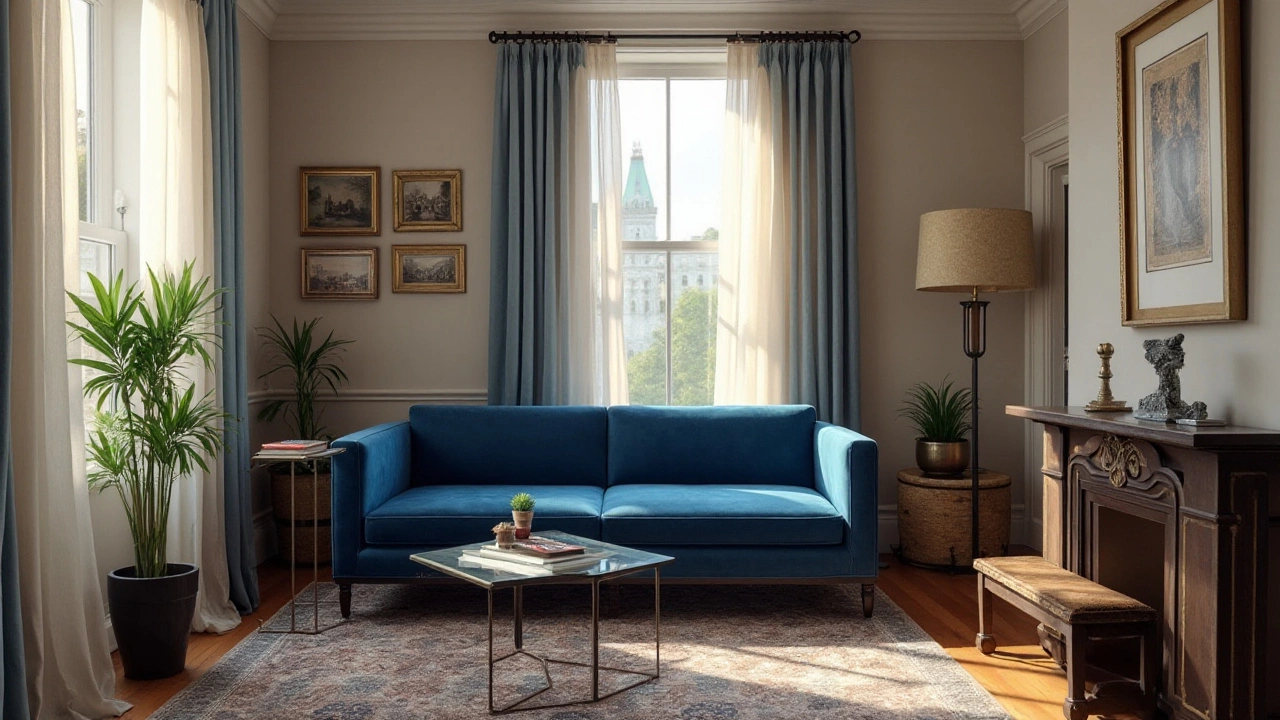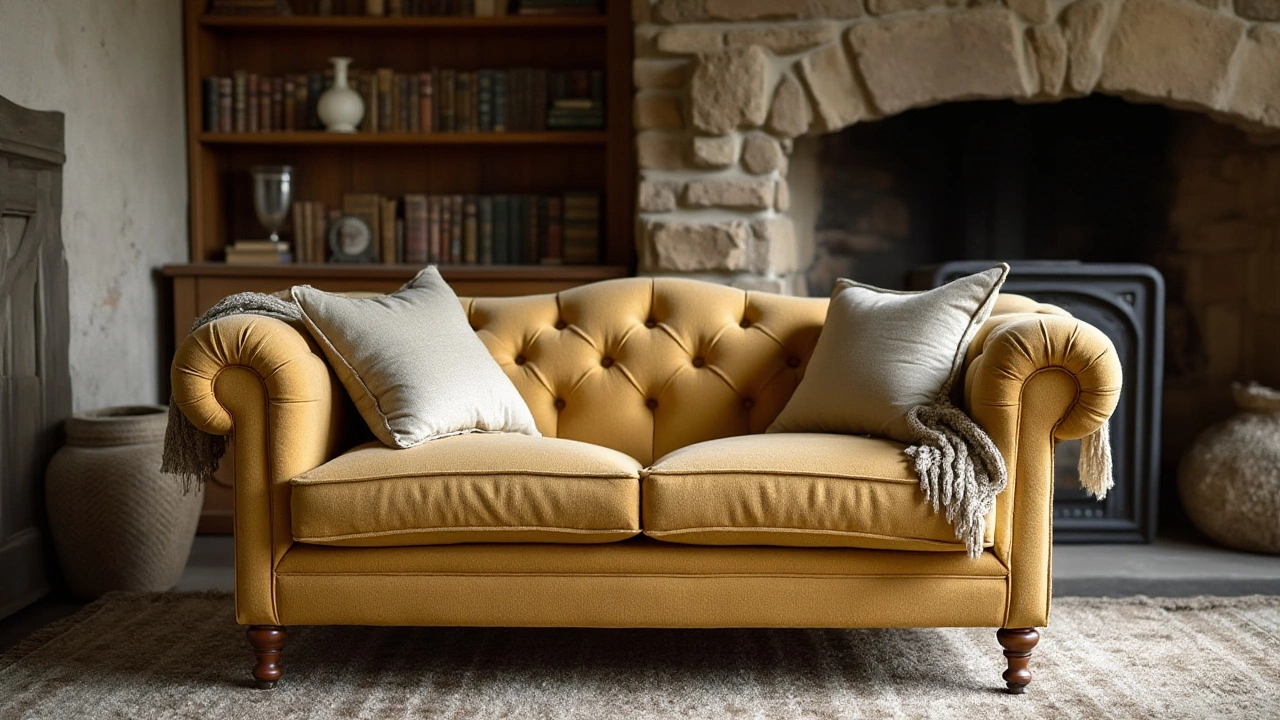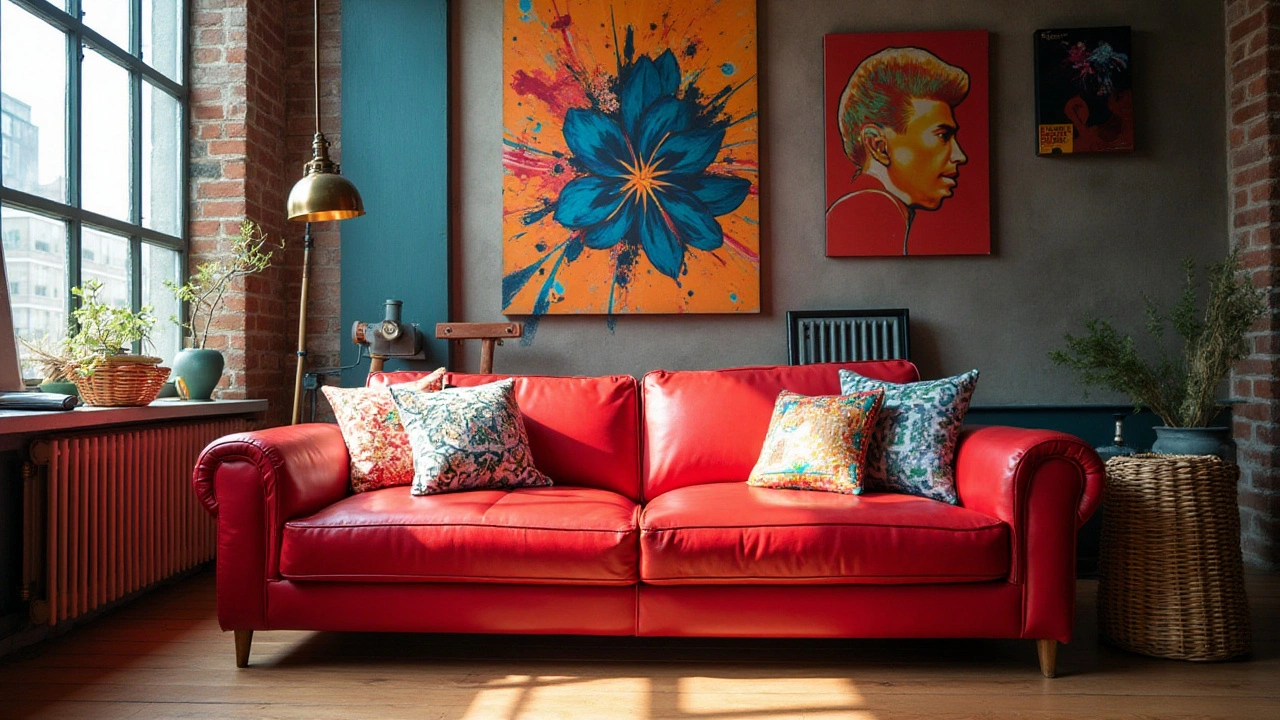Exploring the Charm of a Loveseat: Your Guide to Compact Sofas
 Jan, 31 2025
Jan, 31 2025
When space is a luxury, a small yet stylish seating option can make all the difference in your living room. Enter the loveseat—a practical, versatile, and charming piece of furniture that comfortably seats two people. Known for its compact design, the loveseat has long been beloved by interior decorators and homeowners alike for its ability to fit into tight spaces without sacrificing style or comfort.
The world of loveseats is surprisingly diverse, encompassing a range of materials, styles, and colors to complement any decor. These small sofas are not only about saving space; they also offer an opportunity to add a striking focal point to your room. Whether you prefer a classic leather finish or a plush fabric design, there's a loveseat out there that matches your unique taste and needs. Let's delve into what makes loveseats special, their history, and how you can select the perfect one for your home.
- What is a Loveseat?
- History of Loveseats
- Design Variations and Materials
- Decorating with a Loveseat
- Choosing the Right Loveseat for Your Space
What is a Loveseat?
The term "loveseat" might conjure images of romance and coziness, but its origins are practical. Originally designed during the late 17th century, a loveseat was more than just a small sofa; it was a symbol of sophistication. Initially, these chairs were quite large, meant to accommodate the voluminous dresses worn by women of the era. As fashion evolved, so did furniture, and the loveseat became proportionately smaller and cozier, ideal for seating two people closely.
Fast forward to today, and the small sofa design of the loveseat makes it a popular choice for modern living. Its defining feature is its seating capacity—it typically offers comfortable seating for two people without the excess bulk of a traditional couch. This makes the loveseat a versatile piece that fits well in small apartments, cozy corners, or even as an addition to a larger living room set where space conservation is key. In a time when urban dwellers prize functionality as highly as aesthetics, the loveseat offers the perfect blend of both, proving that good things do indeed come in small packages.
The evolution of this compact couch hasn't stopped at utility. Designers have taken the fundamental aspects of the loveseat and adapted them to fit various interior design trends. By introducing sleek lines, bold colors, or plush textures, loveseats can transform a bland room into a chic, welcoming space. From minimalist Scandinavian designs to more traditional, ornate Victorian styles, a well-chosen loveseat can serve as a statement piece or blend seamlessly with existing furnishings.
One might wonder how such a compact piece of furniture can offer substantial comfort, but the ingenuity lies in its design. Many modern loveseats are built with ergonomic features, ensuring that users can enjoy prolonged seating without discomfort. Manufacturers often incorporate high-density foam cushions and quality fabric that is both durable and pleasing to the touch. In fact, according to a survey by Furniture Today, loveseats are often ranked as one of the top choices for small-family seating, with 60% of respondents choosing a loveseat for its perfect balance between aesthetic appeal and practical use.
If we look to expert opinions, interior designer Jane Churchill once noted,
"A loveseat is the perfect way to add warmth and intimacy to a space. It's both a playful and practical choice, offering unique design opportunities."Such endorsements reflect the ongoing love affair between consumers and loveseats. Picking the right one involves not only focusing on design and color but also considering things like upholstery material, frame construction, and how well it will fit with the rest of the room's ambiance. So whether you're drawn in by its romantic past or its practical present, a loveseat remains a charming and enduring staple in the world of furniture.
History of Loveseats
The history of the loveseat is as intriguing as its functionality, taking us back several centuries. Loveseats first appeared in the 17th century, primarily in Europe and America, serving as a symbol of class and intimacy. Initially, they were larger than the modern-day two-seater sofas, designed to accommodate the bulky dresses of the upper-class women of the time. These seats were not meant solely for couples as the name now suggests. In those days, clothing was quite extravagant, and the additional room provided comfort while maintaining the dignity befitting those grand outfits.
As fashion evolved and clothes became less voluminous, so too did the dimensions of the loveseat. By the 18th century, these seats began to symbolize intimacy and thus were named “loveseats.” Around this period, furniture makers started producing them in a form more recognizable today—compact, comfortable, and ideal for two. Art of the time began featuring these smaller couches, reflecting their growing popularity. Not just practical, loveseats were decorative pieces that could stand alone or enhance the grander seating arrangements of luxury homes.
During the Victorian era, loveseats were often linked with romantic encounters, partly encouraged by the strict social dating decorum that disallowed close mingling between young, unmarried individuals. The loveseat offered a socially acceptable setting where two may sit together, albeit still maintaining a respectable space. By early 19th century, these small couches had become staples in parlors, often upholstered with luxurious fabrics and ornate designs specific to the period's tastes.
Modern times see the love seat taking on new roles and designs. They are celebrated not just for their heritage but their versatility, efficiency, and style. The adaptation continued throughout the 20th and 21st centuries, with designers and manufacturers experimenting with materials like leather, microfiber, and eco-friendly fabrics. Today, the loveseat remains a quintessential piece in numerous households, celebrated for both its practicality and the invitation it offers for relaxation or intimate conversation. In various interiors, it offers a blend of economy and comfort, and continues to capture the hearts of those with an eye for both charm and practicality in furniture.
"A loveseat is not just about design; it transcends time, encapsulating comfort and heritage in every crafted curve." - Design Historian, Camilla Harper

Design Variations and Materials
Loveseats, while compact, offer a surprising range of design variations that can cater to almost any aesthetic preference and functional need. The beauty of a love seat lies in its adaptability and the ability to seamlessly blend with different styles of decor. From sleek and modern designs featuring clean lines and minimalistic upholstery to traditional styles with rich, ornate patterns, the options are vast. These small sofas can be upholstered in a diverse array of materials including leather, cotton, velvet, and polyester blends, each offering its own unique texture and feel. Leather, known for its durability and classic appeal, can offer a sophisticated touch, while velvet adds a layer of plush luxury to any setting. Cotton and polyester blends are often preferred for their ease of maintenance and wide range of color options, allowing more room for personal expression.
Coco Chanel once remarked, "Luxury must be comfortable, otherwise it is not luxury," a sentiment that certainly applies to the choice of materials in furniture design.
The color palette for loveseats varies as widely as their fabric options. While some opt for timeless shades such as black, white, and beige, bolder hues like teal, mustard, or even patterned fabrics can serve as a bold statement piece in a room. The design doesn't end with color and material; it extends to the structural elements as well. Consider whether you prefer a loveseat with or without armrests, high back versus low back, or one with storage options underneath the seating. Each design element can enhance the functionality and comfort of the loveseat, making it not just a piece of furniture but an integral part of the living space.
For those who appreciate sustainability in design, there are loveseats crafted from eco-friendly materials, which include recycled fabrics and sustainably sourced wood. Brands are increasingly mindful of the environment, offering options that not only look good but also do good. When selecting a loveseat, it's crucial to consider both aesthetics and practicality. The choice of fabric might influence the maintenance routine; for instance, leather may require regular conditioning to prevent cracking, while certain fabrics are more prone to staining and might need to be spot-treated more regularly. An informed decision regarding material and design ensures that the loveseat remains a beloved part of your home environment for many years.
Another critical aspect of selecting the right loveseat lies in understanding the space constraints and the intended use of the small sofa. In spaces where flexibility and versatility are key, such as studio apartments or multifunctional rooms, modular loveseats that allow for rearranging pieces to suit varying needs can be invaluable. These designs not only provide seating comfort but also offer practical solutions to the ever-changing human need for adaptable living spaces. With thoughtful consideration of design variations and materials, a loveseat transforms from a mere piece of furniture to a focal point of comfort and style within any living space.
Decorating with a Loveseat
A loveseat presents a world of possibilities when it comes to decorating your living space. This compact piece of furniture can be the linchpin around which the character of your room revolves. Start with the basics—consider the color scheme of your walls and existing furniture. A small sofa in a vibrant hue can add an exciting accent, while a neutral tone promotes a calming ambience. To create a cohesive look, accessorize with throw pillows and blankets that either match or contrast smartly with the loveseat's fabric. Mixing textures, such as velvet with cotton or linen, can infuse depth and interest into your room design, making your loveseat not just a satellite piece but the main attraction.
Lighting plays a significant role in highlighting the presence of a love seat in your room. Position the loveseat near a window to utilize natural light if the room allows, or opt for strategic lamp placements to cast a soft glow that invites guests to sit and relax. Overhead pendants or floor lamps can also be used to create an intimate setting around this cozy seating arrangement. As a general rule of thumb, ensure your lighting fixtures complement the loveseat style. For instance, a modern, minimalist loveseat pairs beautifully with sleek metal lamps, while a vintage piece might call for more ornate lighting designs.
In smaller spaces, the placement of the loveseat is crucial. Positioned against a wall, a compact couch can make a room appear larger, as it opens up the floor for more movement. If room allows, placing it at an angle or in the middle of the room can create distinct areas, segregating living and dining spaces in open-plan settings. Creativity can even extend to utilizing the back of a loveseat as a functional boundary, perhaps flanked by a narrow console table adorned with books or a lamp.
The decor surrounding your loveseat should not be overlooked. Hanging artwork above a loveseat can create symmetry and balance, but be mindful of the height; the artwork should ideally be at eye level when standing. If your style leans toward the eclectic, consider a gallery wall showcasing a montage of framed art and photographs. Alternatively, a mirror can work wonders in reflecting light and making the space feel more expansive. Rugs are another tool to tie the room together—ensure the rug is large enough to anchor the loveseat and a coffee table, creating a cozy zone.
Choosing accessories with functionality in mind can also enhance your loveseat area. Think of small side tables that can hold drinks or books, or a nearby magazine rack for your latest reads. Plants can introduce a breath of fresh air into the space; something as simple as a potted fern or a trailing vine like pothos can soften the edges and infuse vitality.
"To achieve an inviting and harmonious atmosphere, layer textures and play with proportions," suggests interior designer Nilie Herceg. "Balance the substantiality of the loveseat with lighter elements like glass or metal side tables."Taking heed of expert advice can inspire bold choices, mixing modern with classic or industrial with bohemian. Remember, a loveseat is not just furniture; it's an opportunity to create a signature space that resonates with your personal style and complements your living environment beautifully.

Choosing the Right Loveseat for Your Space
Finding the right loveseat for your space might seem daunting, but with a few key considerations, it becomes a pleasurable endeavor. First, assess your living area and think about the function this small sofa will serve. Are you looking for extra seating, or will it be the central piece? A loveseat can work wonders as a cozy reading spot by the window or a welcoming seating area in a hallway. Understanding its purpose will guide your decision more than you might think. Don't forget to measure your space too, as dimensions matter significantly when you have limited room.
When it comes to style, the options are as diverse as they are exciting. Do you lean towards a modern aesthetic, or do you favor something more traditional? Loveseats come in myriad designs, from sleek contemporary models with clean lines to overstuffed versions that scream comfort. Choose a style that reflects your personality and complements your existing decor. Material plays a crucial role too. Leather offers elegance and is effortless to clean, whereas a fabric choice might add warmth and texture to your room. Think about how you'll use it. If you have pets or young children, durability and ease of cleaning should be high on your priority list.
The color of your loveseat can dramatically affect your room’s vibe. Neutral tones are versatile and can easily integrate with most color schemes, but don't shy away from a pop of color if you're aiming for a standout piece. Brightly colored fabrics or bold patterns can transform your loveseat into a striking focal point. Remember, the color should resonate with the emotion you want your space to evoke. Do soft, calming hues appeal to you, or are you drawn to vibrant, energetic shades?
Adding personal touches can elevate the elegance and comfort of your love seat. Accessories, like throw pillows or a snug knitted blanket, can enhance both its appeal and comfort. Contrast plays an essential role when decorating, so mixing textures and colors can add depth and invite interest. Consider these accents as extensions of your style, bringing the overall scene to life, making your space feel more warm and welcoming.
As renowned interior designer Nate Berkus once said, "Your home should tell the story of who you are, and be a collection of what you love brought together under one roof." This perspective highlights the importance of investing time in choosing the perfect loveseat that not only fits your space but also aligns with your personal narrative.
Finally, whether you're purchasing online or at a physical store, take time to test your options. If possible, sit on the loveseat to gauge comfort level and make sure the dimensions suit both your space and your body. When ordering online, read reviews and pay attention to any delivery and assembly options provided. This simple step ensures you get the best experience from start to finish, helping guarantee that the loveseat you select is one you’ll love for years to come. Finding the right loveseat is more than just a purchase; it's an addition that speaks volumes about who you are and where you call home.